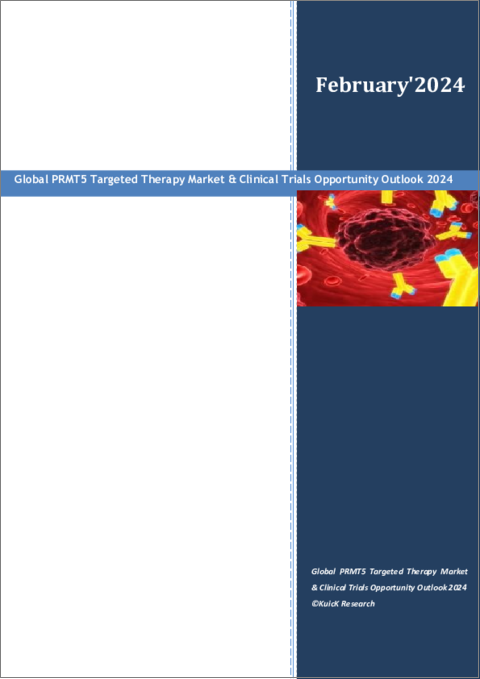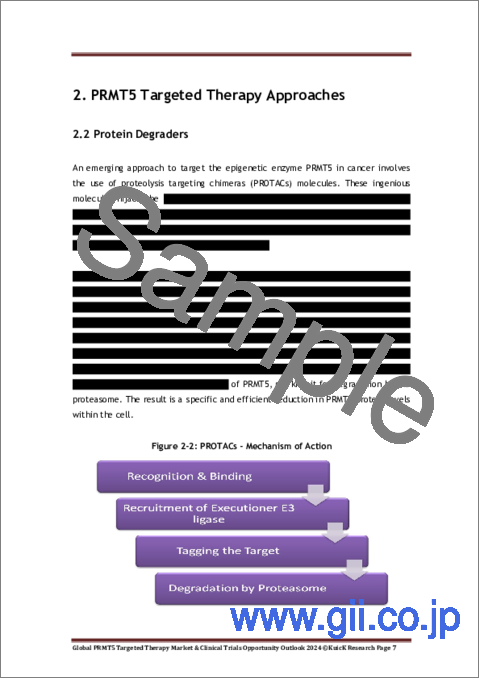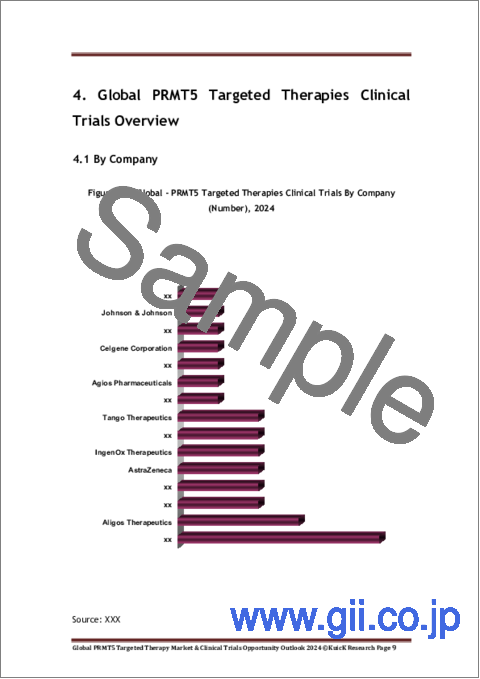|
|
市場調査レポート
商品コード
1422231
PRMT5標的療法の世界市場と臨床試験の機会見通し:2024年Global PRMT5 Targeted Therapy Market & Clinical Trials Opportunity Outlook 2024 |
||||||
|
|||||||
| PRMT5標的療法の世界市場と臨床試験の機会見通し:2024年 |
|
出版日: 2024年02月01日
発行: KuicK Research
ページ情報: 英文 50 Pages
納期: 即日から翌営業日
|
全表示
- 概要
- 図表
- 目次
PRMT5(Protein Arginine Methyltransferase 5)は、細胞内で様々な機能を有する重要な酵素です。PRMT5は通常、ヒストンタンパク質の対称および非対称ジメチル化を触媒し、翻訳後の修飾に重要な役割を果たしています。しかし、過去20年間に実施された研究により、PRMT5の制御異常が様々な疾患プロセスを促進することが明らかになっており、魅力的な治療標的となっています。PRMT5標的療法市場はまだ初期段階にあり、有望な候補化合物の中止による挫折もあるが、現在の市場情勢は、PRMT5標的療法が幅広い疾患に対する様々な治療レジメンの重要な構成要素になる可能性がある未来を指し示しています。
PRMT5の最初の研究はがんに焦点を当てたもので、PRMT5が多様なタンパク質サブクラスに属する多数の基質をメチル化し、さまざまながん促進作用をもたらすことが発見されました。例えば、PRMT5が転写制御因子E2F1をメチル化すると、その半減期が短縮され、大腸がんにおいて発がん性が示唆されます。同様に、DNA損傷応答タンパク質であるTDP1のメチル化は、その活性を高め、がん細胞死を防ぐ。スプライシングタンパク質であるSRSF1のPRMT5を介したメチル化もまた、急性骨髄性白血病における発がん活性に関連しています。その結果、PRMT5を阻害することは、固形がんと血液がんの両方に対して幅広い抗がん作用を示します。
がん以外にも、PRMT5は自己免疫疾患や炎症性疾患にも関連しており、PRMT5はほとんど未知の経路を介して異常な免疫反応や炎症を引き起こします。PRMT5は、NF-κB経路を介してCD4+T細胞の発達を促進し、IL-2の産生と増殖を上昇させる。さらに、PRMT5レベルはメモリーTh細胞増殖の最盛期に上昇しました。同様に、微生物感染、特にウイルス感染においても、PRMT5は病原体の生存や抗ウイルス・抗菌反応に関係しています。PRMT5の治療効果を調べる臨床研究が増えていることによると、この領域はまだ十分に研究されていないが、PRMT5阻害剤で治療できる可能性があります。
現在、複数の低分子PRMT5阻害薬が研究および臨床試験中です。2015年にEpizymeとGSKがEPZ015666を開発したことは、PRMT5標的薬の分野における分岐点となっています。EPZ015666は、他の20種のタンパク質メチル化酵素に対して20000倍以上の選択性を有する、PRMT5初の低分子化学阻害剤でした。両社はまた、EPZ015666の類似体であるEPZ015938も開発したが、戦略的な検討のため、両プログラムとも断念しました。それにもかかわらず、両社はPRMT5を抗がん剤の治療標的として確立するための枠組みを作り、またPRMT5の作用を制限する低分子阻害剤の可能性を示しました。
AMG 193、AZD3470、TNG462、SCR-6920のような次世代阻害剤は、PRMT5の特定の部位との相互作用を最適化することにより、特異性の向上を示しています。これらは異種移植モデルにおいて腫瘍増殖抑制効果を示しています。加えて、PRMT5ががん以外のいくつかの疾患においても文脈に基づく機能を有することを考慮すると、プロテオライシス・ターゲティング・キメラ(PROTACs)技術やPRMT5活性化剤も代替的なターゲティング・アプローチを提供します。
PRMT5阻害の効果を高めるために、単剤療法にとどまらず、前臨床試験や臨床試験において併用療法も検討されています。PRMT5とBCL-2の二重阻害は、単独療法よりも治療効果を高める可能性を示しています。このような併用は、単剤での治療効果を制限する代償的な生存シグナル伝達を克服することを目的としています。アムジェン社もPRMT5阻害剤AMG193と既存の化学療法剤ドセタキセルとの併用療法を評価しています。
当レポートでは、世界のPRMT5標的療法市場について調査し、PRMT5標的療法の歴史と進化の概要とともに、臨床試験の機会、適応症別、地域別動向、および市場に参入する企業のプロファイルなどを提供しています。
目次
第1章 PRMT5標的療法のイントロダクション
- 概要
- PRMT5標的療法の歴史と進化
第2章 PRMT5標的療法アプローチ
- 低分子阻害剤
- タンパク質分解剤
- 低分子活性化剤
第3章 PRMT5標的療法の役割、適応症別
- がん
- 自己免疫疾患および炎症疾患
- 心血管疾患
- 微生物感染症
第4章 世界のPRMT5標的療法の臨床試験の概要
- 会社別
- 適応症別
- 場所別
- 患者セグメント別
- 相別
第5章 企業、適応症、相別の世界のPRMT5標的療法の臨床試験
- 研究
- 前臨床
- 第I相
- 第I/II相
- 第II相
第6章 PRMT5標的療法の研究と地域別市場動向
- 米国
- 英国
- EU
- 中国
- カナダ
第7章 PRMT5標的療法市場の動向と臨床試験の見通し
- 現在の市場動向、開発、臨床試験の評価
- 将来の商品化の可能性
第8章 PRMT5標的療法市場力学
- 促進要因と機会
- 課題と抑制要因
第9章 競合情勢
- Abbisko Therapeutics
- Agios Pharmaceuticals
- Amgen
- AstraZeneca
- Aurigene Oncology
- CytosinLab Therapeutics
- Epizyme (Ipsen)
- IngenOx Therapeutics
- Johnson & Johnson
- Jubilant Therapeutics
- Mirati Therapeutics
- Ryvu Therapeutics
- Schrodinger
- Simcere Pharmaceutical Group
- SK Life Science
- Tango Therapeutics
List of Figures
- Figure 1-1: PRMT5 - Normal Functions
- Figure 1-2: PRMT5 - Oncogenic Functions
- Figure 1-3: PRMT5 - Important Milestones in Development
- Figure 2-1: PRMT5 - Binding Sites for Small Molecule Inhibitors
- Figure 2-2: PROTACs - Mechanism of Action
- Figure 2-3: PROTACs - Advantages
- Figure 3-1: PRMT5 - Roles in Solid Cancers
- Figure 3-2: PRMT5 - Roles in Hematological Cancers
- Figure 3-3: PRMT5 - Roles in Diabetes
- Figure 3-4: PRMT5 - Roles in Microbial Infections
- Figure 4-1: Global - PRMT5 Targeted Therapies Clinical Trials By Company (Number), 2024
- Figure 4-2: Global - PRMT5 Targeted Therapies Clinical Trials By Indication (Number), 2024
- Figure 4-3: Global - PRMT5 Targeted Therapies Clinical Trials By Location (Number), 2024
- Figure 4-4: Global - PRMT5 Targeted Therapies Clinical Trials By Patient Segment (Number), 2024
- Figure 4-5: Global - PRMT5 Targeted Therapies Clinical Trials By Phase (Number), 2024
- Figure 6-1: NCT05094336 Phase 1/2 Study - Initiation & Completion Year
- Figure 6-2: NCT05528055 Phase 1 Study - Initiation & Completion Year
- Figure 8 1: PRMT5 Targeted Therapies Market - Drivers & Opportunities
- Figure 8 2: PRMT5 Targeted Therapies Market - Challenges & Restraints
List of Tables
- Table 6-1: US - Ongoing Studies for PRMT5 Inhibitors
- Table 6-2: UK - Ongoing Studies for PRMT5 Inhibitors
- Table 6-3: EU - Ongoing Studies for PRMT5 Inhibitors
- Table 6-4: China - Ongoing Studies for PRMT5 Inhibitors
- Table 6-5: Canada - Ongoing Studies For PRMT5 Inhibitors
“Global PRMT5 Targeted Therapy Market & Clinical Trials Opportunity Outlook 2024 ” Report Highlights:
- PRMT5 Targeted Therapies Clinical Trials By Company, Indication & Phase
- PRMT5 Targeted Therapies In Clinical Trials: > 25
- PRMT5 Targeted Therapies Research & Market Trends by Region: US, UK, EU, China & Canada
- Current Market Trends, Developments & Clinical Trials Assessment
- PRMT5 Targeted Therapy Approaches
- Application Of PRMT5 Targeted Therapies by Indication
PRMT5, or Protein Arginine Methyltransferase 5, is an important enzyme with a variety of functions in cells. PRMT5 normally catalyzes the symmetrical and asymmetrical dimethylation of histone proteins, which plays an important role in post translational modifications. However, research studies conducted over the last two decades have revealed that its dysregulation promotes various disease processes, making it an attractive therapeutic target. Though the PRMT5 targeted therapies market is still in its early stages, with setbacks caused by the discontinuation of promising candidates, the current market landscape points to a future in which PRMT5 targeted therapies may become essential components of various treatment regimens for a wide range of diseases.
The initial research efforts for PRMT5 were focused on cancer, where it was discovered that PRMT5 methylates numerous of its substrates, which belong to diverse protein subclasses, resulting in varying pro-cancer effects. For example, PRMT5's methylation of the transcription regulator E2F1 shortens its half-life, which has oncogenic implications in colon cancer. Similarly, methylation of TDP1, a DNA damage response protein, increases its activity, hence preventing cancer cell death. PRMT5-mediated methylation of SRSF1, a splicing protein, has also been linked to carcinogenic activities in acute myeloid leukemia. As a result, inhibiting PRMT5 has a wide anticancer effect on both solid and hematological malignancies.
Beyond cancer, PRMT5 is linked in autoimmune and inflammatory diseases, where PRMT5 causes abnormal immune responses and inflammations via largely unknown pathways. PRMT5 promotes CD4+ T cell development via the NF-κB pathway, leading to elevated IL-2 production and proliferation. Furthermore, PRMT5 levels were elevated during the height of memory Th cell proliferation. Similarly, in microbial infections, particularly viral infections, PRMT5 has been linked to pathogen survival as well as antiviral and antibacterial responses. Again, this area is under-researched, but it has the potential to be treated with PRMT5 inhibitors, according to an increasing body of clinical investigations looking into the therapeutic benefits of PRMT5.
Multiple small-molecule PRMT5 inhibitors are now under research and clinical testing. The development of EPZ015666 by Epizyme and GSK in 2015 was a watershed moment in the field of PRMT5-targeted medicines. EPZ015666 was the first small chemical inhibitor of PRMT5 with over 20000-fold selectivity over 20 other protein methyltransferases. The two companies also developed EPZ015938, an analog of EPZ015666, but both programs were abandoned due to strategic considerations. Nonetheless, they laid the framework for establishing PRMT5 as a therapeutic target for anticancer therapies, as well as the potential of small molecule inhibitors to limit PRMT5 actions, both of which are still being widely investigated in research.
Next-generation inhibitors like AMG 193, AZD3470, TNG462 and SCR-6920 demonstrate improved specificity by optimizing interactions with particular sites on PRMT5. These have shown tumor growth inhibition in xenograft models. In addition, proteolysis targeting chimeras (PROTACs) technology and PRMT5 activators also offer alternative targeting approaches, considering PRMT5 has context-based functions in several diseases outside cancer.
Beyond monotherapies, combination strategies are also being explored in preclinical and clinical trials to enhance PRMT5 inhibition efficacy. Dual inhibition of PRMT5 and BCL-2 has shown potential for enhanced therapeutic effects, better than what was seen by the therapies alone. Such combinations aim to overcome compensatory survival signaling that can limit the therapeutic benefits of single agents. Amgen is also assessing the combination of its PRMT5 inhibitor AMG 193 in combination with the established chemotherapy drug, Docetaxel.
Regulatory bodies such as the FDA have also aided the development of PRMT5-targeted therapies by granting them designations, allowing their developers to obtain certain benefits. For example, in February 2023, the FDA designated JBI-778, a highly differentiated, substrate competitive PRMT5 inhibitor being developed by Jubilant Therapeutics, as an orphan drug for the treatment of Glioblastoma Multiforme. JBI-778 is being developed as an oral, brain-penetrant PRMT5 inhibitor for the treatment of both brain metastases and primary brain cancers. The Orphan Drug Designation grants tax breaks and market exclusivity upon approval, which can assist JBI-778 establish itself as a preferred therapy after marketing approval.
Commercially, targeting PRMT5 in order to inhibit or activate its functions represents a novel and viable strategy; however, this entirely depends on clinical benefits demonstrated in preclinical and clinical trials in specific indications. Given the potential broad applicability of PRMT5-targeting therapies, the first-in-class therapeutic to target PRMT5 may achieve high sales. Combination therapies could further expand market size. However, realizing the full clinical and commercial potential will require validating efficacy and defining suitable patient populations through biomarker-guided trials.
Table of Contents
1. Introduction to PRMT5 Targeted Therapy
- 1.1. Overview
- 1.2. History & Evolution of PRMT5 Targeted Therapy
2. PRMT5 Targeted Therapy Approaches
- 2.1. Small Molecule Inhibitors
- 2.2. Protein Degraders
- 2.3. Small Molecule Activators
3. Role of PRMT5 Targeted Therapies by Indication
- 3.1. Cancers
- 3.1.1. Solid Cancers
- 3.1.2. Hematological Cancers
- 3.2. Autoimmune & Inflammatory Diseases
- 3.3. Cardiovascular Diseases
- 3.4. Microbial Infections
4. Global PRMT5 Targeted Therapies Clinical Trials Overview
- 4.1. By Company
- 4.2. By Indication
- 4.3. By Location
- 4.4. By Patient Segment
- 4.5. By Phase
5. Global PRMT5 Targeted Therapies Clinical Trials By Company, Indication & Phase
- 5.1. Research
- 5.2. Preclinical
- 5.3. Phase-I
- 5.4. Phase-I/II
- 5.5. Phase-II
6. PRMT5 Targeted Therapies Research & Market Trends by Region
- 6.1. US
- 6.2. UK
- 6.3. EU
- 6.4. China
- 6.5. Canada
7. PRMT5 Targeted Therapies Market Trends & Clinical Trials Outlook
- 7.1. Current Market Trends, Developments & Clinical Trials Assessment
- 7.2. Future Commercialization Opportunity
8. PRMT5 Targeted Therapies Market Dynamics
- 8.1. Drivers & Opportunities
- 8.2. Challenges & Restraints
9. Competitive Landscape
- 9.1. Abbisko Therapeutics
- 9.2. Agios Pharmaceuticals
- 9.3. Amgen
- 9.4. AstraZeneca
- 9.5. Aurigene Oncology
- 9.6. CytosinLab Therapeutics
- 9.7. Epizyme (Ipsen)
- 9.8. IngenOx Therapeutics
- 9.9. Johnson & Johnson
- 9.10. Jubilant Therapeutics
- 9.11. Mirati Therapeutics
- 9.12. Ryvu Therapeutics
- 9.13. Schrodinger
- 9.14. Simcere Pharmaceutical Group
- 9.15. SK Life Science
- 9.16. Tango Therapeutics





